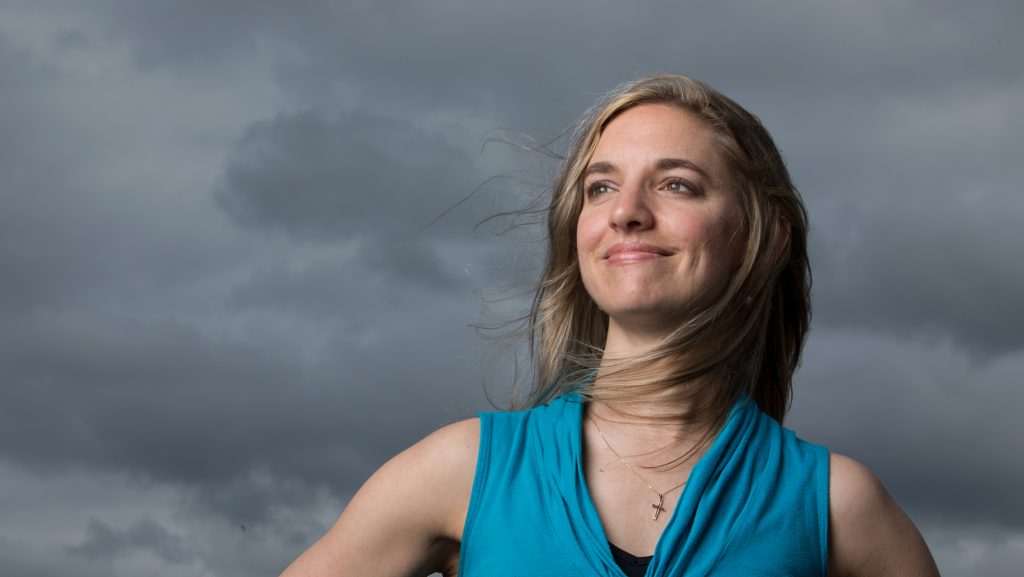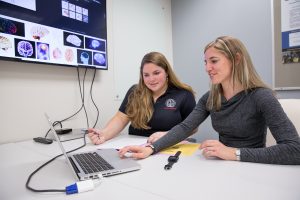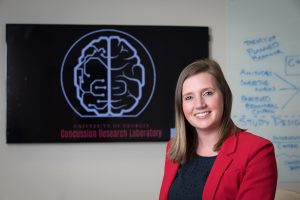Coping with Concussions The survivor of eight concussions, this athlete aspires to be a leading expert on sleep and concussions as an athletic trainer and clinical researcher.
By Cynthia Adams | Photos by Nancy Evelyn
Nikki Hoffman is a fourth-year UGA doctoral candidate in Kinesiology, with emphasis on biomechanics and athletic training. Prior to several events that affected her physically, athletic training was at the center of her universe. She had wanted to be an athletic trainer since she was an active seventh grader growing up in Dover, Delaware. “I wanted to help people,” says the diminutive graduate student, who graduates this year. Everything—including serious setbacks—led Hoffman to this moment, and this path, she says. After earning a bachelor’s degree in athletic training at the University of Delaware, Hoffman finally got the opportunity she had dreamed of at Delaware State University, where she became an athletic trainer. She also served as the interim head athletic trainer for 19 other sports teams. It was all she had hoped for, Hoffman says. “I loved it.”
Opportunities opened. She worked clinically as a graduate assistant trainer at James Madison University and Eastern Mennonite University after finishing at Delaware. Then Hoffman began working full time as an associate athletic trainer.
But fate intervened, and by accident of fate, her primary career focus was redirected.
After multiple injuries, Hoffman transitioned to the Movement Science Department at DSU, and began concussion research. She became a research project manager and clinical adjunct instructor.
Today, Hoffman aspires to be a leading expert on sleep and concussions as an athletic trainer and clinical researcher. She is analyzing and publishing data from the largest multi-site funded project on the topic of exploring concussions and how sleep duration influences recovery. Hoffman’s manuscript, “Influence of Post-Concussion Sleep Duration on Concussion Recovery in Collegiate Athletes” was accepted by the Clinical Journal of Sport Medicine last year.
In this researcher’s case, she brings powerful, and direct personal experience to bear.
When a younger, avid soccer player, Hoffman fearlessly headed the ball. Her 5’3” stature made her even more fierce, she jokes. “In 7th grade, I got injured a lot because I was a very aggressive athlete.” For many years, Hoffman competed unscathed insofar as head injuries. “I never had any issues with concussion. Then my first concussion happened when I was finishing my master’s degree. Playing intramural soccer, I took a ball to the temple.”
The blow to her head happened in 2005, and Hoffman vividly remembers what would become a disastrous series of events. She felt dazed; the experience was different than anything she had experienced beforehand. “I was a little disoriented. I had a moderate headache and felt nauseous. I sought medical care.”
Hoffman grasped the seriousness of it, yet the true depth of what had happened wasn’t immediately obvious. Her first impression was to blow it off. “I thought, I didn’t feel so good. I would rest. I’d get back to what I was doing.”
And then, just as she was back in pursuit of athletic training, she had what can only be described as a run of extremely bad luck. Her injuries kept multiplying. “I had eight concussions between 2005 and 2012.” Many of Hoffman’s concussions were accidental events, others were sports-related.
There is a body of evidence that maintains that women suffer more concussions and experience them differently than males. Statistically, women soccer players have a 2.1 times greater risk of suffering a concussion than males.
In a recent Scientific American article by Bob Roehr, there are gender-specific lines of demarcation concerning concussion outcomes.
In comparable sports “female rates of concussions are much higher than those of their male counterparts,” says Zachary Kerr, director of the National Collegiate Athletic Association (NCAA) Injury Surveillance Program. Over a five-year period, the rates per 1000 athlete-exposures were 6.3 in females versus 3.4 in males in soccer, 6.0 in females versus 3.9 in males in basketball and 3.3 in females versus 0.9 in males in baseball and softball. Only in swimming and diving did male rates (0.3) exceed those of females (0.5). Headache, dizziness and difficulty concentrating were roughly similar among both sexes, Kerr says. But among injured high school athletes, “larger proportions of females are reporting sensitivity to light, sensitivity to noise, nausea and drowsiness,” he says. “They were also slower to return to normal activity.”
New research on subconcussive hits, meaning, ones that don’t necessarily elicit a concussion, is also troubling.
“When a teenager is hit in the head, his brain can begin to show signs, within days, of the kind of damage associated with degenerative brain disease, according to an unsettling new study of young men and head injuries,” The New York Times reported in February.
“The findings, which also involve tests with animals, indicate that this damage can occur even if the hit does not result in a full-blown concussion.”
In postmortem analyses of the brains of football players, there is evidence of tissue damage and also of a protein which has the ability to “strangle and kill brain cells.” The article references a small study published in Brain, which sought to determine how, and how quickly, head injuries can contribute to further damage that can become chronic.
This could potentially mean “that young girls may be limited on heading the ball until a certain age, but this area still needs further exploration” says Hoffman.
Despite all the setbacks, Hoffman carried on. She powered forward, working for six years as an athletic trainer while teaching at Delaware State as an adjunct. She told herself she’d be fine.
“Once you’ve seen one concussion, you’ve seen ONE concussion, and it’s not going to affect another the same way…it is so variable.” -Nikki Hoffman
But she was increasingly skittish. She began to recoil when people tried to hug her for fear of an accidental blow. It was a realistic fear. As Hoffman explains it, the eight concussions she suffered in a space of seven years were not all sports-related—several were freak accidents.
“In one case, I got hit in the head with a toy by a toddler,” she says. In another instance, she was struck in the head by someone working out with a resistance band which suddenly broke. “It ricocheted and hit me in the head.”
Hoffman jokes: “Destiny was hitting me on the head. I took the hint. After my fourth or fifth concussion, in 2009, I took myself out of sports.”
After sustaining eight concussions, the trajectory of her plans shifted. The eighth concussion forced her to take several months off to recover.
One of the toughest aspects?
Dealing with a sense of depression, Hoffman’s memory and ease of learning were affected.
“I found things that I love to do. But, I sat in this period of depression. Because of my concussions, my memory wasn’t the same. My stress levels were increasing. My neuropsychologist said I should consider another career option. So instead of letting it defeat me, I decided to find another path.”
She reflected upon teaching, something that the outgoing and and helping part of Hoffman’s personality enjoyed. Teaching offered those opportunities. Was athletic training a closing chapter of her life?
“My medical condition forced me to pursue teaching.”
High School Sports Concussion Statistics
Head impacts and concussions caused by contact sports are a quickly growing epidemic among young athletes. When left undetected, concussions can result in long-term brain damage and may even prove fatal.
- 47 percent of all reported sports concussions occur during high school football.
- 1 in 5 high school athletes will sustain a sports concussion during the season.
- 33 percent of high school athletes who have a sports concussion report two or more in the same year.
- 4 to 5 million concussions occur annually, with rising numbers among middle school athletes.
· 90 percent of diagnosed concussions do not involve a loss of consciousness.- An estimated 5.3 million Americans live with a traumatic brain injury-related disability (CDC).
Hoffman was still at Delaware State, “and then I realized I didn’t want to lose athletic training, plus to teach at a higher level, I had to have the educational level above a masters.”
Hoffman entered UGA’s Department of Kinesiology in 2014. She was initially attracted to the department, and her interest in UGA was cemented when she learned about the recent hiring of Julianne Schmidt.
“I had heard about a new faculty member who was passionate about research,” Hoffman says. “And, the department of Kinesiology at Georgia had a strong reputation.”
Georgia offered “lots of opportunities that I couldn’t pass up.” Hoffman was now focused upon earning a doctorate degree.
Schmidt became her principal investigator.
“She is also young and eager to get involved in many aspects of concussion research, and learned that I was looking to become involved in sports-related concussion research.”
“The research here meant I could stay involved with athletes even though I wouldn’t work with them full time. By the end of my first year, I was looking at many different areas within concussion research. My advisor encouraged me to look at novel areas, sleep being one of them.”
Hoffman understood how sleep had impacted her in the aftermath of her own injuries. “I knew sleep had affected me from my own experiences. I wanted to add research that would be useful to clinicians. I soon knew that my work would be in sleep and concussion recovery.”
She dug in, employing all the determination that had made her a good athlete and athletic trainer to manage the medical issues that accompanied multiple concussions.
In much the same way that an athlete would power back from any other physical injury, Hoffman persevered in order to cope.
“I wanted this [degree]; that is the biggest thing. People start PhD programs, have a family and it becomes too much. I want this for my future. It isn’t an option to quit; I just find a way. I couldn’t have done this without the foundation I had.”

Nikki Hoffman: In My Own Words “For the longest time, my career end goal was to work within Division I collegiate athletics as an athletic trainer. It became my identity and I was passionate about helping others. However, life happens when you are busy making other plans. I sustained a series of concussions between 2005-2012. A history of multiple concussions can elicit long-lasting effects, such as chronic headaches, dizziness, increased emotional symptoms, and sleep disturbances. My short-term memory was never the same.” “After personally experiencing long-term sleep disturbances following my concussions, I realized that I have a lot of unanswered questions. Through my research, I want to become a leading researcher in sleep and concussion recovery. Even though I can no longer practice full-time as an athletic trainer, my path will continue to make an impact on others, which was my ultimate goal all along.”
That foundation included supportive, encouraging family and friends.
Hoffman discovered compensatory ways to approach doctoral work. Memorization was taxing; memory issues challenged her to double down on study habits. Whereas she noticed how others could read an article and remember it, “I began to take notes and create a summary.”
She found it helpful to discuss complex reading with fellow graduate students.
“I’ve been a high-achieving student my entire life,” she explains. No matter how difficult it might be to focus or retain information, Hoffman was determined to find compensatory means to do it.
“Everything I’ve worked towards, I’ve worked for, but maybe a little harder. I write things down, or talk things out with friends.”
But even the perennial optimist was challenged by the challenges of the doctoral experience. Hoffman concedes, “I notice my stress level is higher at the PhD level.”
At this moment in time, a triumphant-feeling Hoffman is writing her dissertation. She finds more tailwinds than headwinds. There is a sense of this being the right time, right place for her research.
“There is a growing awareness of concussion,” she says. “Rest and sleep following concussion is becoming a very strong area.”
Hoffman used her experience with an eye to helping others.
“I thrive on people interactions,” she admitted while attending the Emerging Leaders Program last fall. Emerging Leaders is a leadership program sponsored by the UGA Graduate School, and the participants must be referred by faculty. During a training exercise in which EL participants were asked to share things about themselves, Hoffman discussed having suffered eight concussions.
Hoffman not only openly shared her experiences with fellow graduate students, but encouraged questions.
There are 200 patients involved in concussion studies and research at the UGA University Health Center.
- Hoffman working with student researcher Olivia Feltner at the University Health Center.
- Dr. Julianne Schmidt, Hoffman’s mentor and professor
“Some are athletes, some simply had an accident. The clinical resource is a great thing, as it provides benefits for free,” says Hoffman.
To that end, she works with 20 concussed and 20 non-concussed college-aged students, with ages ranging from 18-24.
“I want to know what does sleep have to do with concussion recovery. So, maybe I will look at naps down the road. My sleep research is going to take me to the rest of my career,” she says, emphasizing how much is yet to be known.
“We already know what sleep does for healthy people. I want to establish a foundation, saying this is what I know from this sample population…we can build upon this.”
She emphasizes that there are no garden-variety concussions. She knows whereof she speaks.
“Once you’ve seen one concussion, you’ve seen ONE concussion, and it’s not going to affect another the same way…it is so variable,” Hoffman says. Those variables include gender as well as a host of others to weigh.
At the University Health Center, Hoffman accumulates additional information. “There is a graded symptom checklist, computerized neurocognitive testing, and balance performance tasks, all essential to providing a comprehensive evaluation of concussed patients.” All are also done at no cost to the student.
Obtaining objective data concerning the impact of sleep in concussion recovery requires subjects use a wrist-worn accelometer that measures sleep based upon movement.
“My research is so unique,” she says. “What makes it unique is that I’m able to track a participant throughout their recovery. That data isn’t currently available.”
But compliance with wearing the watch isn’t always what she hoped, especially with participants who take longer to recover. So, she also asks the subjects to keep a sleep journal.
“I know from previous research that subjective questionnaires don’t sync up. People think they sleep better than what we’re seeing.” To compensate for this, Hoffman uses both subjective and objective questionnaires, and analyzes the data as a next step.
The more she has learned, the more Hoffman hopes to improve future concussion management protocols.
Hoffman no longer runs or plays soccer, but stays fit through noncompetitive activities. She works out doing fitness routines, paddle boarding, and hiking.
“I’m still athletic,” she stresses. “You can find other things you love to do.” She also describes being resilient as one of her most important resources.
“My parents raised me to believe if something doesn’t work, do it another way.”
Hoffman completed her doctorate in May, and has a job lined up at Illinois State University in Normal, Illinois, where she will begin working in August. “My parents are elated,” she says.
“Now, I am very happy, yet I recognize the way I am limited. I cannot remember things as easily as I used to…it’s okay to write things down.”
Her advice to others who are currently concussed or still feeling limited by concussions?
“Find new ways to compensate for your limitations. And find new ways to release stress.”
She plans to resume one stress-relieving hobby: visiting all major league stadiums within the country, an outlet for stress release. She can’t wait to see Wrigley Field. Of course, Hoffman will keep a very close eye out for random pop-up balls.

Sleep and Concussion Recovery “I want to know what sleep has to do with concussion recovery…We already know what sleep does for healthy people. I want to establish a foundation we can build upon.” Hoffman says in order to obtain objective data concerning the impact of sleep in recovering from concussion, she requires subjects to wear a wrist worn accelometer. The device gathers data continuously day and night until their symptoms subside. “My research is so unique,” Hoffman says. “What makes it unique is that I’m able to track a participant throughout their recovery.” The more she has learned, the more Hoffman hopes to improve future concussion management protocols.
Further Reading:
https://www.cdc.gov/headsup/basics/concussion_recovery.html
Info on the UGA Health Center and Concussion Research: (https://coe.uga.edu/research/labs/uga-concussion-research)










